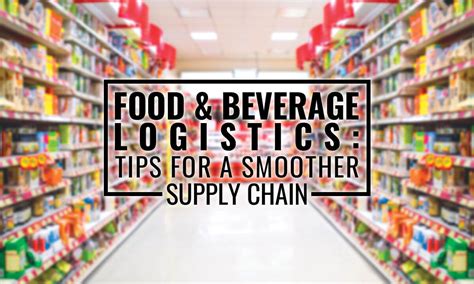The Complete Recipe for Success: Mastering Food and Beverage Logistics
The food and beverage (F&B) industry is a dynamic and demanding sector, with razor-thin margins and extremely high stakes when it comes to product quality and safety. A successful F&B business hinges significantly on efficient and effective logistics. This comprehensive guide will delve into the key ingredients of a winning F&B logistics strategy.
1. Understanding the Unique Challenges of F&B Logistics
Unlike other industries, F&B logistics faces unique hurdles:
-
Perishability: Maintaining the quality and safety of temperature-sensitive products requires meticulous temperature control throughout the entire supply chain. Spoilage represents a substantial financial loss, making cold chain management paramount. This includes specialized transportation, storage, and handling procedures.
-
Shelf Life: Close monitoring of expiration dates is critical to minimize waste and ensure products reach consumers before they expire. Sophisticated inventory management systems are necessary to effectively track stock and manage rotation.
-
Food Safety Regulations: Stringent regulations govern food handling and transportation, demanding meticulous adherence to safety protocols to avoid contamination and comply with local and international standards. HACCP (Hazard Analysis and Critical Control Points) implementation is essential.
-
Traceability: The ability to track products throughout the supply chain is vital for quickly identifying the source of any contamination or quality issues. This ensures product recalls can be managed efficiently and effectively.
-
Demand Fluctuation: F&B demand can fluctuate significantly due to seasonal changes, events, and trends. Logistics operations need to be agile and adaptable to meet these changing demands without compromising efficiency.
2. Key Components of an Effective F&B Logistics Strategy
Building a robust logistics system requires careful consideration of these key elements:
-
Strategic Sourcing and Procurement: Selecting reliable suppliers who prioritize quality and adhere to strict safety standards is fundamental. This includes careful assessment of supplier capabilities and their logistics infrastructure.
-
Efficient Warehousing and Storage: Optimizing warehouse space, implementing effective inventory management systems, and employing appropriate temperature-controlled facilities are crucial for minimizing waste and ensuring product freshness. First-In, First-Out (FIFO) inventory management is vital for perishables.
-
Transportation and Distribution: Choosing the right mode of transportation (refrigerated trucks, rail, air freight) based on product type, distance, and delivery timeframe is essential. Real-time tracking and route optimization technologies can improve efficiency and reduce transit times.
-
Inventory Management: Precise inventory control is crucial for minimizing waste, optimizing stock levels, and preventing stockouts. This requires employing advanced inventory management systems with real-time data visibility.
-
Order Fulfillment and Last-Mile Delivery: Streamlining the order fulfillment process, ensuring accurate and timely deliveries, and building strong relationships with delivery partners are essential for customer satisfaction.
3. Leveraging Technology for Enhanced Efficiency
Technology plays a critical role in optimizing F&B logistics:
-
Warehouse Management Systems (WMS): These systems automate various warehouse operations, enhancing efficiency and improving accuracy in inventory tracking and order fulfillment.
-
Transportation Management Systems (TMS): TMS platforms optimize transportation routes, monitor shipments in real-time, and facilitate communication between stakeholders, improving delivery efficiency and reducing costs.
-
Cold Chain Monitoring Systems: Real-time temperature tracking systems ensure the maintenance of the cold chain, minimizing risks associated with temperature fluctuations and product spoilage.
-
Blockchain Technology: Blockchain enhances traceability by providing a transparent and immutable record of product movement throughout the supply chain, improving food safety and accountability.
4. Building a Strong Team
Successful F&B logistics relies on a skilled and dedicated team:
-
Experienced Logistics Managers: Experienced professionals who understand the unique challenges of F&B logistics are crucial for overseeing operations, optimizing processes, and resolving issues.
-
Trained Personnel: Warehouse staff and drivers need to be adequately trained in handling perishable goods, adhering to safety regulations, and operating specialized equipment.
-
Strong Communication Networks: Effective communication is essential between all stakeholders, ensuring smooth collaboration and efficient problem-solving.
Mastering F&B logistics is a journey, not a destination. By carefully considering these elements and embracing technology, businesses can optimize their supply chains, minimize waste, and enhance customer satisfaction— ultimately leading to increased profitability and a strong competitive advantage.
